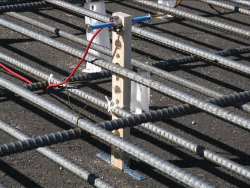0-6190
Use of Dowel Bars at Longitudinal Construction Joints
Abstract
The primary objective of this research project was to develop rational guidelines on the use of dowel bars in longitudinal construction joints (LCJs) for better-performing concrete pavements without potential longitudinal cracking problems. To thoroughly investigate the behavior of tied and/or doweled concrete pavements, field testing was conducted in several new continuously reinforced concrete pavement (CRCP) construction projects in Texas. Concrete strain gages, concrete displacement gages, and steel strain gages were installed in each test section. To achieve the primary objective of this study in a more effective way, theoretical analysis was performed along with field experimentation. It was found from field experimentation that subgrade drag theory (SGDT) – currently used for tie bar design – is not adequate to accurately analyze the behavior of concrete pavements. Accordingly, an improved numerical model based on plane strain theory was developed to analyze a concrete pavement with tie bars at LCJs. To verify the validity of the numerical model, the analysis results were compared with the field data – transverse displacements across the LCJs, concrete stresses, and tie bar stresses. The comparison indicated a good correlation when both frictional restraint and curling effects were included in the analysis. The influences of multiple lane ties and pavement geometries on the stresses in concrete and tie bars were investigated through parametric studies using the numerical model. Although the stresses in tie bars and concrete increase as more lanes are tied together, the growth slows due to bond slip at the interface between tie bars and concrete. This means that the dowel bar placement instead of tie bars could reduce concrete stresses if it applies to wide pavements, while it could result in lane separation problems. On the other hand, concrete stresses do not increase any further if four or more lanes are tied together, and concrete stresses may not be high enough to cause longitudinal cracking. There are many miles of CRCP in Texas where more than four lanes and inside and outside concrete shoulders are tied together, with no longitudinal cracking. Accordingly, it is recommended from the findings in this study not to use dowel LCJs, as is the current practice
Project PI: Moon C. Won

Center for Multidisciplinary Research in Transportation (TechMRT)
-
Address
Texas Tech University, Box 41023, Lubbock, TX 79409-1023 -
Phone
806.742.3523 -
Email
techmrt.outreach@ttu.edu
